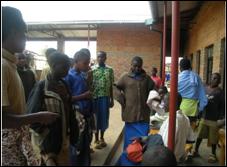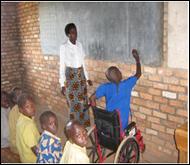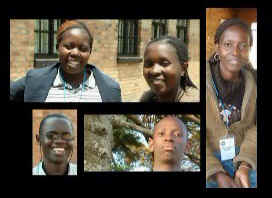

www.YouTube.com/ThoughtFieldTherapy
www.YouTube.com/AssociationTFT
· Featured Video: Tapping: The Thought Field Therapy Trauma Relief Tapping Algorithm
tinnitus, vertigo, and pain
www.YouTube.com/ATFTFoundation


We have received a request from Father John Mary Vianney, a priest of Byumba Catholic Diocese in the northern district of Rwanda. He heard from a seminarian, KATANGA Raphael (salesian of Don Bosco) about our work with traumatized people.
Father Vianney has asked for us to come to his diocese as there are many cases of children and youth who suffer from HIV/AIDS, loss of family, disabilities, genocide survivors and other. They have requested a team come in July 2009 to train and treat. Dr. Caroline Sakai is willing to go in late July and stay two weeks. They want to have us train about 30 people who can then assist others in their community. The people of Byumba at NYINAWIMANA have built a center that they call the IZERE Center. The word seems to mean peace and reconciliation.
 Those who have been trained will treat others at the IZERE Centers in the other communities. They want us to also treat some cases of trauma at the IZERE Center. They have about 300 people that they would like treated but we may have to limit the amount of people treated during depending on how many ATFTF Trauma Relief therapists are deployed.
Those who have been trained will treat others at the IZERE Centers in the other communities. They want us to also treat some cases of trauma at the IZERE Center. They have about 300 people that they would like treated but we may have to limit the amount of people treated during depending on how many ATFTF Trauma Relief therapists are deployed.
They propose to make a small ATFT group formed of the 30 newly trained therapists who will treat others at the IZERE Center. They want us to supervise the newly trained therapists as much as possible before our departure.
Goal: To improve on the lives of the people affected by genocide, war, poverty and physical handicaps.
1. Begin a program focused on treatment of the effects of trauma caused by genocide and psychological effects of poverty and being physically handicapped.
2. To identify people affected by genocide (trauma cases), poverty (orphans, widows, handicapped people, and traumatized people) and to group them according to their needs.
3. Sensitivity training and education aimed at creating peace, forgiveness, unity, reconciliation and confidence among neighbors, and to cultivate a spirit of collaboration and mutual help.
-To provide physical and emotional treatment to all people
-To continue training; Members of the IZERE Centre will train and supervise others
-Counseling
– Reduction in the cases of trauma
– Increased knowledge about trauma and how to
diagnosis it.
– Ease education of traumatized children
– Good relationships among people (peace, forgiveness, reconciliation).
Suzanne Connolly TFT-Adv
*Note: ATFT Foundation is an IRC Section 501(c)(3) public charity to which contributions are deductible for federal (USA) income tax purposes in accordance with the provisions of IRC Section 170.

CASE NOTES from the 2009 Rwanda Trauma Relief Mission
By Suzanne Connolly, LCSW, LMFT, TFT-Adv
During these two days we treated over 60 people from the district of Byumba, the young and old, all of them poor people of the countryside who live by sustenance farming. These were persons who wanted to participate in the study but due to the fact we had prepared materials for 200 only, they had to be excluded. Father Jean Marie Vianney reported that there was some upset because they couldn’t participate and so we decided to treat them ourselves over a period of two days.
 Suzanne Connolly says, “My first client on the 16th lost her only parent and her beloved fiance in the genocide of 1994. She was given shelter in a refugee camp in the Congo, and while there married and had children. When she was able to return to Rwanda she and her husband had to be tested for the HIV virus. Unfortunately her
Suzanne Connolly says, “My first client on the 16th lost her only parent and her beloved fiance in the genocide of 1994. She was given shelter in a refugee camp in the Congo, and while there married and had children. When she was able to return to Rwanda she and her husband had to be tested for the HIV virus. Unfortunately her
husband tested positive. She lost several children, likely to AIDS, and she now practices safe sex. Her husband is very sick and cannot work. Her life is very sad because of these losses and because she alone must work very hard to support the family. She wants to have more peace about her losses and difficult circumstances. In a very short time, by using TFT, this woman was able to feel peace around her present circumstances. Her SUD level went from a ten to a one and the change in her facial expression was remarkable.
Another young woman, only twenty-two years old with a young baby has a husband who drinks too much, and insults her. He sometimes tells her to sleep outside with the chickens. She reported that she gets so angry she cries. She loses her voice and cannot even speak. We talked about not arguing with him or defending herself verbally when he’s drinking as it does no good, but at the same time, not agreeing with him. She could say things like, “That’s your opinion, I don’t think this, but we can agree to disagree”, and she can still keep her dignity. But more importantly, she cannot be assertive in this way if she is so anxious and upset that she cannot even find her voice and literally cannot speak.
Using TFT we worked on her sadness and her fear and anger around her husbands “bad behavior” and she could no longer work up the upset she previously experienced. She could now picture herself being positive in the face of her husband’s bad behavior. Her throat was not constricted and she felt like she had a voice even under these circumstances.
The last person I treated on August 16th lost her husband and all seven of her children in the genocide of 1994. She understandably reported much sadness. She couldn’t even imagine feeling peace after this tragedy in her life. She reported that she has flashbacks during the day and flashbacks that wake her up at night. She has had very bad dreams consistently and was afraid at night. She suffered from painful feelings of loneliness. We used TFT to address her symptoms of trauma. Her face, which was very sad when she arrived, began to brighten and eventually her frown grew into a huge smile. Her worn but beautiful face glowed and she was full of hugs and gratitude. She now could not bring up any sadness. Her only concern was that these good feelings might not last. I assured her, as I had assured the others, that likely the good feelings would last, the bad feelings they worked on almost never return.
I told her that the Rwandan therapists will now be working at the Center and would be able to help her should any of these fears and other negative feelings return.
One man reported only physical symptoms. He suffered from headaches, back-aches stomach-aches and chest pains. He often couldn’t work and felt very sad and reported feeling like ‘half a man’.
He had been to several clinics and nothing seemed physically wrong with him. He said that he is not bothered by the trauma of the past. He ran from the perpetrators who were chasing him with guns and escaped by hiding.
However, most of his family was killed. At the same time, he reported no anger, fear, feelings of guilt or sadness. However as we conversed he mentioned flashbacks and bad dreams. His flashbacks were so severe that when he experienced them his neighbors accused him of being crazy. When he thought about the events that came back to him as flashbacks and bad dreams he reported a SUD of 8. We worked with the memories that come up during his bad dreams and flashbacks and he soon felt only feelings of peace. He was not experiencing pain at the time of his treatment because he was taking pain medication for his symptoms. We are hoping that by addressing his symptoms of trauma his physical symptoms of pain will also be reduced as these symptoms appeared for the first time soon after the genocide.
One woman whose husband was killed during the genocide spoke of the double pain she experienced because he was a person of a certain ethnic group and was mistaken for a person of another ethnic group and killed. Because of their relationship to him, she and her children were pursued but she was able to hide herself and her children. One of the children was killed a week later by a bomb and another has been missing and presumed dead since 1994. She has one child in secondary school that did very well but she could not afford school fees so the girl now lives at home and cannot go on with her studies. She is not entitled to genocide survivor benefits because of her ethnic identity. Her daughter’s having to drop out of school was the woman’s greatest concern and greatest cause of anxiety. TFT successfully addressed her feelings of despair and after about an hour and forty five minutes of treatment to address her past trauma and her current anxieties she reported a feeling of peace in her heart when remembering her losses and in thinking about her current unfortunate circumstances.
Another woman was eleven years old in April of 1994. Whenever she sees soldiers she has intense fear although Rwanda is not at war and the soldiers now work as peace keepers. It is unclear what she witnessed or experienced concerning soldiers in 1994, however her fear of soldiers seemed crippling, as soldiers are everywhere in Rwanda. At one point, while she was concentrating on her fear she opened her eyes and looked at our interpreter and said, ‘You are a soldier’. This young woman’s fears were successfully alleviated to the point where she could think about seeing them along the road and be able to pass by them and even greet them.
During these two days I treated fourteen persons all with similar problems to the ones above. Others included alcoholism, loneliness and three women who had intense fears of the loved ones they lost coming back as ghosts during the night.
Between us we successfully treated 58 of the sixty persons who had not been admitted into the study due to the 200 study slots allotted already having been filled.

By Paul Oas, M.Div., PhD., TFT Dx
 |
The “Street Children” of the El Shaddai Orphanage in Kigali, Rwanda |
In April of 2006, a 10 member Mission Team traveled under the sponsorship of the ATFT (Association for Thought Field Therapy) Foundation, www.TFT.org., to Rwanda and the Congo to do research and provide trauma therapy and training. They used and taught the revolutionary process of trauma relief developed by Dr. Roger Callahan, author of “Stopping the Nightmares of Trauma.” (For a brief synopsis of the TFT process, see www.TFTrx.com.)
Below see the heart-opening experience of the ATFT team being welcomed by 400 singing orphans. You can also see other ATFT videos on YouTube.
The ATFT Trauma Relief Team being welcomed by 400 singing orphans.
Their focus was primarily on the 400 “Street Children” of the El Shaddai Orphanage in Kigali, Rwanda, “home” for those orphaned by the 1994 genocide and subsequent AIDS and poverty.
 |
| El Shaddai Orphanage, “home” for those orphaned by the 1994 genocide and subsequent AIDS and poverty. |
The Team was co-sponsored by Christ Lutheran Church in San Diego, who has raised $35,000 of the $48,000 pledged to feed and bed the 400 orphans for a year. Five of the Team were from CLC. (www.Christpb.org).
This team’s mission statement was: “To help create healing and stability in Rwanda by using Thought Field Therapy to heal the wounds of trauma and by training Rwandans and the Congolese to use TFT to help their fellow citizens heal the wounds of the past and move forward to create a strong, peaceful and healthy nation.”
The goals of the 2006 mission team included the following:
 |
| Our travel-weary volunteers, captivated by the singing orphans. |
What motivates 10 Americans from the ages of 29-75 to leave jobs, practices, spouses, children and the comforts of home to travel thousands of miles to the heart of Africa – a country replete with war, genocide, corruption, disease, poverty and seeming hopelessness?
You will have to ask them!
I can only share some observations.
In selecting the team, these were the qualities I initially looked for and found:
 |
| Flowers, smiles, song and dance greeted our tired team upon their arrival. |
On the road, April 10:
 |
| Smiling faces and inquiring eyes, filled with hope for what we may be able to do.
|
Toss in 2 sleepless nights on crowded airlines by team members attempting to bivouac in Nairobi from Hawaii, LA, Phoenix, DC and Kuait, a flight cancellation from Nairobi, Kenya to Kigali, Rwanda, and arriving “shower less” and disheveled 4 hours behind schedule.
Reluctantly we honored the insistence of Pastor Peter Ilungalutum, the Director of the El Shaddai Orphanage, to “stop by” and be welcomed by 400 children orphaned by the 1994 genocide, AIDS and poverty.
We were bounced and whisked to an abandoned warehouse where these hundreds of former “street children” had been waiting 4 hours to welcome our arrival.
 |
| Genocide victims, both young and old, working hard to fill out their PTSD questionnaires. |
What we experienced then was impossible to describe without tears welling up again. It was for me the signature experience of our mission. As 10 weary travelers descended from packed Land Rovers into a cave like entrance to the warehouse, voices of 400 orphans singing at the top of their lungs was overwhelming in its stark contrast to what we anticipated.
We saw faces beaming with joy and animation, eyes wide with excitement. For over an hour they mesmerized us with singing and dancing. Like Ravel’s “Bolero,” the beat and dance escalated until our “Raggedy Ann” travelers were “seduced” onto their feet – joining hearts and feet in a crescendo of connection.
 |
| Dottie Webster sharing Easter Sunday with the orphans. |
We were there to “heal” them? This experience alone was worth the “price of admission.”
With but an hour to travel to our lodging, splash water on our faces, run a brush through hair – most were on time for our 4:00 p.m. staff meeting with our local hosts and Embassy volunteers.
The Presbyterian Guest House was our domicile for the next two weeks. There were clean rooms, mosquito net draped beds, showers and bath. (Electricity and hot showers were sporadic, but “shower sharing” rescued us.)
 |
| Caroline Sakai explaining about the TFT therapy and study. |
Tasks at hand:
Due to typical African communications, Suzanne Connolly’s training of 35 psychologists, pastors and teachers was postponed for 10 days.
This allowed time for Caroline Sakai to rally the team to the task of therapy and research. Having recently returned from two deployments to New Orleans and Green Cross Certification, Caroline launched into the formidable details involved in adequately translating our PTSD approved testing instruments into Kinyarwandan and receiving approval by its author. This became an amazing team effort requiring many trips to the Internet Café until appropriate and adequate translations were acceptable and in place.
The team worked till late at night assembling research and training materials. Days were spent in testing and treating as many children and staff as possible.
 |
| Additions to daily protein and nutrition were welcomed. |
Meanwhile, 3 of the team, Carl Johnson, Beth Bates and Paul Oas left for the Congo and Northern Rwanda to provide training and follow up continuing education for last year’s trainees in Goma and Ruhengeri.
Now, time for a weekend break!
Six of our team journeyed to the mountains separating Rwanda from Uganda and the Congo to track down the elusive Silverback Gorillas of “Gorilla’s in the Mist” fame.
Their mountain climbing trek through thick jungle rewarded them by a literal “brush” with the gorillas and left them rain soaked and mud caked as ecstatic reincarnations of “Diane Fossey.”
 |
| We taught the children to “sew” with the donated machines. |
Our final week was no less exciting and rewarding. 35 students arrived from the Congo and various parts of Rwanda for the two-day training in TFT. (Due to the extreme poverty in Africa, it was necessary to subsidize students for travel, food, lodging and training.)
The training was led by Suzanne Connolly, a seasoned tutor and traveler. Since January, she already had two training deployments prior to Rwanda: New Orleans and Kuwait.
With 6 assistants and a translator, the students not only learned the basics, they also experienced relief from their own pent up traumas, which helped solidify their education and experience.
 |
| Suzanne Connolly leading the TFT Algorithm Level training for the local community. |
The remainder of our time was spent in treating as many of the orphans and staff as possible and to ensure that protocols for research follow up were in place.
Farewells were heart wrenching, as affection-starved children were once again being “abandoned.” Clothes were drenched with intermingled tears as orphans clung to new friends and “surrogates” from America.
It was now impossible to determine — who had healed whom?
 |
| The sad good-byes. |
